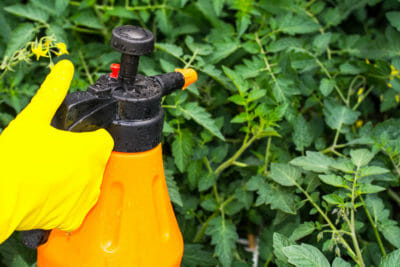|
Listen To The Article
|
 [1]
[1]As a home vegetable gardener, you can use all-natural bug sprays instead of harmful commercial pesticides.
Ahhhh, the lazy days of summer! The mere mention of it brings up images of sunbathing at the beach or sitting on a patio sipping a frosty beverage. For the home vegetable gardener, summer means reaping the rewards of your hard work that you put in over the spring. It means juicy ripe tomatoes, zucchini, and hot peppers turning a crimson red.
That is not to say that there are no duties for you to undertake in your vegetable garden during the summer – there are. But it tends to be a much shorter list when you compare it to everything that you need to do during the spring and fall. And that’s just perfect for the gardener on vacation.
Home Vegetable Gardener: Summer Checklist
1. Flower Pinching
Summer is a time when many of the plants in your garden are going into reproductive mode. This is great for plants that you eat the fruit from such as peppers, zucchini, and tomatoes. But, unless you are looking for seeds, this is not so great for herbs. These plants are also starting to flower at this time. When herb plants like basil, oregano, and others start to flower, you should pinch off those flowers immediately. This is because once the plant starts to go into reproductive mode, the stems become tough and woody and the flavor becomes more bitter.
Again, if you are looking for seeds, you can let them go. Nevertheless, that particular plant will not be as nice for eating once it flowers.
2. Succession Planting
One of the best ways that a home vegetable gardener maximizes his or her garden space is succession planting. This practice consists of following one crop with another. Many crops that are planted in the spring can be planted again in late summer for a fall harvest.
New Natural Fertilizer Doubles Garden Production! [2]
Succession planting requires a little planning and know-how, but the results are definitely worth it. Pull out any old crops that you will not be saving seed from in order to make room for the new. As weather during the late summer starts to cool down, you can start planting cool weather crops again such as lettuce. Other crops you can consider for a fall harvest are kale, snap beans, spinach, carrots, beets, cauliflower, and broccoli. With less daylight, these late crops tend to take longer to mature. However, these mid-to-late-summer plantings make your autumn dinner table all the more bountiful.
3. Pests
Like spring, the summer season brings with it its own set of garden pests. Japanese beetles, grasshoppers, whiteflies, and other intruders view your garden as a delectable smorgasbord. Moreover, if you don’t stop them in their tracks, they might just get more produce from your vegetable garden than you do!
Alternative Methods For Bug Control
If you’re having a particularly buggy year, you might be tempted to blast the unwanted creatures with toxic chemicals and pesticides. But if eating those chemicals – or feeding them to your family – is as unappealing to you as it is to me, consider these alternatives.
Use All-Natural Bug Spray
One method [3] incorporates a mixture of chili peppers in water, while another uses all-natural diatomaceous earth [4]. Either way, bugs will run — or die.
Floating Row Covers
Translucent white, porous fabric is used to cover your prized veggies. It lets in light while keeping creepy crawlies out. The fabric can be draped over metal hoops, wooden frames, or wrapped around tomato cages.
Traps
Some people swear by various forms of traps that attract certain insects and then contain them. If you do decide to go this route, be warned that this type of trap can often have the effect of attracting more pests than you had before and could make the problem worse. If you decide to go with traps, make sure they are a good distance away from your vegetable garden.
Hand Picking
Now some vegetable gardeners might get a little grossed out at the idea of combing their lettuce for sticky slugs or extracting menacing-looking Japanese beetles from your pepper plants. Nonetheless, hand-picking is one of the few ways that will guarantee a reduction in the pest population in your garden. In addition, some gardeners actually revel in providing a meal of freshly killed bugs to their backyard birds. Or, if you’re really squeamish about hand-picking, then get your kids or the neighborhood kids to do the dirty work for you. Give them containers and “wanted” posters with pictures of the offending pests. Then, offer to pay them a “bounty” – maybe 25 cents (and even more for smaller gardens) – for each dead white fly, slug, or beetle they can produce from your vegetable garden.
One of the best things about summer garden maintenance for the home vegetable gardener is that, unlike early spring, you are already enjoying the fruits (or veggies) of your labor. Also, unlike late fall, you still have time to plant, tend, and harvest even more. Ahhhh summer!
What are other ways you maintain your garden through fall? Share your tips in the comments section below.
Sign up for Off The Grid News’ weekly email and get $600 worth of survival blueprints … free! [5]
